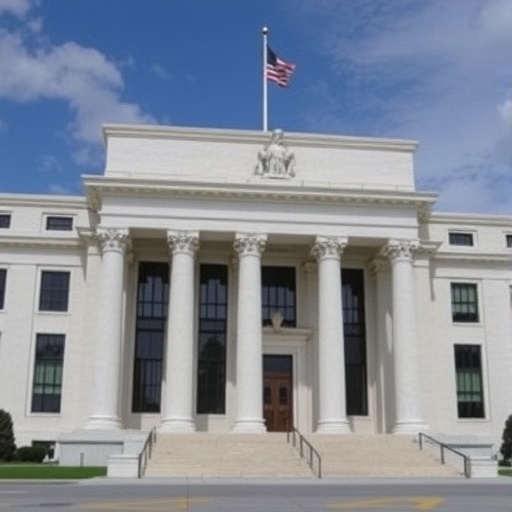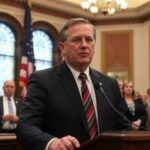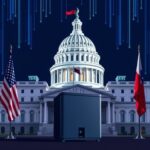In a closely watched decision that sent ripples through global markets, the Federal Reserve announced on Wednesday that it will maintain current interest rates at a range of 5.25% to 5.50%, opting for stability over aggressive cuts or hikes. This move, aimed at taming persistent inflation while nurturing economic growth, comes at a pivotal moment as U.S. consumer spending shows resilience but unemployment ticks upward. Chair Jerome Powell emphasized during the post-meeting press conference that ‘the economy remains robust, but we must remain vigilant against inflationary pressures.’
- Fed’s Rationale: Navigating Sticky Inflation in a Cooling Economy
- Borrowers Feel the Squeeze: Mortgage and Credit Card Rates in Focus
- Wall Street’s Mixed Signals: Stocks, Bonds, and the Dollar’s Dance
- Expert Voices: Economists Debate the Path to Sustainable Growth
- Looking Ahead: Rate Cut Timeline and Global Ripples
The decision, which was widely anticipated by economists but still sparked volatility in stock indices, underscores the Fed’s delicate balancing act. With inflation hovering at 3.2% year-over-year—above the central bank’s 2% target—the Fed is signaling confidence in a ‘soft landing’ scenario where growth continues without tipping into recession. Markets reacted swiftly: the S&P 500 dipped 0.8% initially before recovering, while the 10-year Treasury yield climbed to 4.3%.
Fed’s Rationale: Navigating Sticky Inflation in a Cooling Economy
The Federal Reserve‘s choice to hold interest rates steady was rooted in a comprehensive review of recent economic data. Core PCE inflation, the Fed’s preferred gauge, eased to 2.6% in August from 2.7% the prior month, but shelter costs and energy prices remain elevated. Powell noted, ‘We’ve made substantial progress on inflation, but it’s not defeated yet. Premature easing could undo our gains.’
Supporting this stance, the U.S. Bureau of Labor Statistics reported that nonfarm payrolls added 187,000 jobs in September, slightly below expectations but indicative of steady economic growth. The unemployment rate held at 4.1%, a level considered healthy, yet wage growth at 4.0% annually outpaces productivity in some sectors, fueling inflationary concerns. Fed officials projected in their updated Summary of Economic Projections (SEP) that GDP growth will moderate to 2.1% for 2024, down from 2.5% earlier estimates, reflecting caution amid geopolitical tensions like the ongoing Ukraine conflict and Middle East instability.
Historically, the Fed has hiked rates aggressively since March 2022, lifting the federal funds rate by 525 basis points to combat post-pandemic inflation that peaked at 9.1%. This pause marks the third consecutive meeting without change, allowing the central bank to assess the lagged effects of prior tightening. Economists at Goldman Sachs highlighted in a note that ‘the Fed’s data-dependent approach is prudent, as real-time indicators like the ISM Manufacturing Index at 47.2 signal contraction risks without outright recession.’
Borrowers Feel the Squeeze: Mortgage and Credit Card Rates in Focus
For everyday Americans, the unchanged interest rates mean continued pressure on borrowing costs, a direct extension of the Fed’s policy. The average 30-year fixed mortgage rate lingers around 7.1%, per Freddie Mac data, deterring homebuyers and contributing to a sluggish housing market. Existing home sales fell 2% in September to an annualized rate of 3.96 million units, the lowest since 1999 outside of recessions.
Credit card rates, already at record highs averaging 21.5%, show no signs of relief, exacerbating household debt that now totals $17.5 trillion. A survey by the New York Fed revealed delinquency rates rising to 3.2% for credit cards, up from 2.8% a year ago, as families grapple with elevated living costs. ‘This hold is a gut punch for young families looking to buy homes,’ said Mark Zandi, chief economist at Moody’s Analytics. ‘Without rate cuts, the dream of homeownership slips further away for millennials and Gen Z.’
On the flip side, savers benefit from higher yields on certificates of deposit (CDs) and high-yield savings accounts, now offering 4.5% to 5.0% APY. This has encouraged a shift in consumer behavior, with deposits in money market funds surging 15% year-over-year to $6.1 trillion, according to the Investment Company Institute. For retirees relying on fixed incomes, these rates provide a buffer against inflation-eroded purchasing power.
- Key Impacts on Consumers:
- Mortgage applications down 4% week-over-week, per the Mortgage Bankers Association.
- Auto loan rates averaging 7.8%, leading to a 10% drop in new vehicle sales.
- Student loan borrowers face unchanged federal rates at 5.5% for undergrad loans.
Wall Street’s Mixed Signals: Stocks, Bonds, and the Dollar’s Dance
The financial markets’ response to the Federal Reserve‘s announcement was a tale of cautious optimism. While the Dow Jones Industrial Average closed down 0.3% at 42,150, tech-heavy Nasdaq gained 0.5%, buoyed by expectations of sector-specific resilience. Bond traders pushed yields higher, interpreting the hold as a signal that rate cuts might be delayed until mid-2025.
The U.S. dollar index strengthened 0.7% against major currencies, reaching 106.5, which could dampen export-driven economic growth for manufacturers. ‘A stronger dollar is a double-edged sword,’ explained Lisa Shalett, chief investment officer at Morgan Stanley Wealth Management. ‘It curbs import inflation but squeezes corporate profits from overseas operations.’
Looking at broader implications, the decision aligns with global central banks’ trajectories. The European Central Bank recently cut rates by 25 basis points, while the Bank of Japan maintains ultra-loose policy. This divergence could heighten capital flows into U.S. assets, supporting stock valuations but risking asset bubbles in sectors like commercial real estate, where office vacancy rates hit 20% in major cities.
Investment strategists recommend diversification: ‘With interest rates on hold, focus on quality dividend stocks and short-duration bonds to mitigate volatility,’ advised BlackRock’s Rick Rieder in a client letter. Year-to-date, the S&P 500 has returned 18%, outpacing global peers, underscoring America’s economic primacy.
Expert Voices: Economists Debate the Path to Sustainable Growth
Reactions from the economic community were varied, with many praising the Federal Reserve‘s measured approach. ‘This is the right call—inflation is cooling without derailing jobs,’ said Austan Goolsbee, president of the Chicago Fed, in an interview with CNBC. However, critics like former Treasury Secretary Larry Summers warned that ‘holding too long risks tipping the economy into slowdown,’ pointing to softening retail sales data showing a 0.1% decline in August.
Academic insights add depth: A study from the Brookings Institution analyzed 50 years of Fed pauses, finding they precede easing cycles 70% of the time, often leading to 1-2% GDP boosts in the following year. Conversely, the Peterson Institute for International Economics cautions that persistent high interest rates could shave 0.5% off economic growth annually if prolonged.
Regional perspectives highlight disparities. In the Midwest, manufacturing hubs like Detroit benefit from stable rates supporting capex, while coastal tech centers in Silicon Valley decry higher venture debt costs, with startup funding down 22% from 2022 peaks per PitchBook data.
- Pro-Hold Arguments: Sustains labor market strength; prevents reacceleration of prices.
- Criticisms: Increases recession odds to 35%, per JPMorgan estimates.
- Alternatives Suggested: Targeted fiscal stimulus to aid lower-income households.
Institutional investors are adjusting portfolios accordingly. Vanguard’s outlook report forecasts 3% annualized returns for U.S. equities over the next decade, tempered by elevated valuations at 22x forward earnings.
Looking Ahead: Rate Cut Timeline and Global Ripples
As the Federal Reserve enters its observation phase, all eyes are on upcoming data releases like the October jobs report and Q4 GDP figures. Powell indicated that a December rate cut remains ‘on the table’ if inflation trends toward 2%, with dot plot projections showing two 25-basis-point reductions by mid-2025. This timeline could unlock pent-up demand in housing and autos, potentially accelerating economic growth to 2.5% in 2025.
Globally, the decision influences emerging markets, where higher U.S. interest rates attract capital outflows from countries like Brazil and India, pressuring their currencies. The IMF’s latest World Economic Outlook revised global growth to 3.2% for 2024, crediting U.S. resilience but warning of trade disruptions from potential tariffs under a new administration.
For businesses, the hold encourages strategic planning: Small firms, per the National Federation of Independent Business, report 45% planning expansions if rates ease soon. Policymakers in Washington are urged to complement monetary efforts with fiscal measures, such as infrastructure spending, to sustain momentum.
In essence, the Fed’s steady hand positions the U.S. economy for a potential rebound, but uncertainties—from election outcomes to AI-driven productivity gains—will shape the path forward. Investors and households alike should prepare for a data-driven December, where the next chapter of this monetary saga unfolds.









